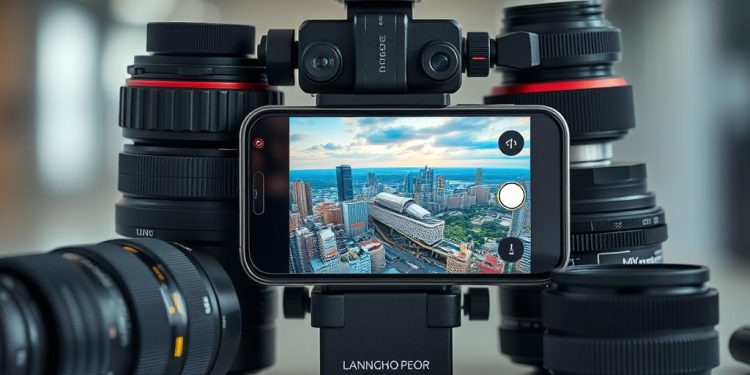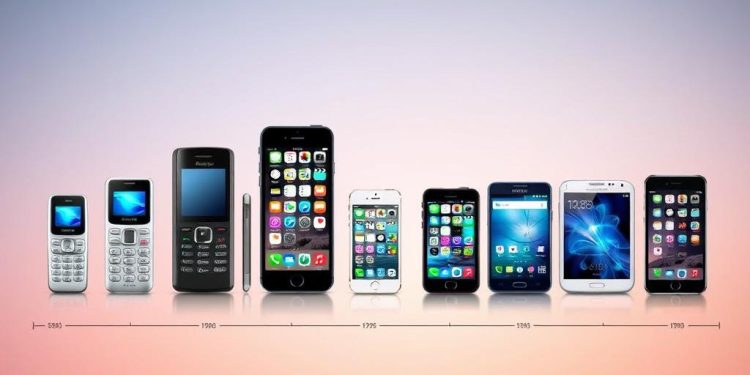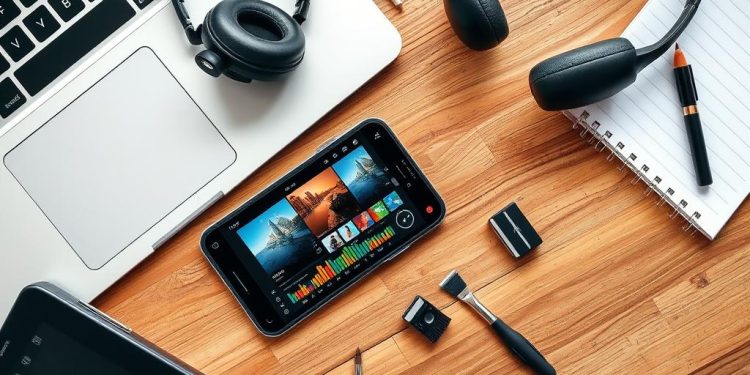Welcome to the exciting world of advanced mobile photography! As smartphone technology continues to evolve, anyone can capture stunning images with just a device in their pocket. In this section, you’ll discover essential smartphone photography tips that will take your skills to the next level. From understanding your smartphone’s camera settings to harnessing the power of editing tools, we’ll guide you in mastering the ins and outs of mobile photography.
With the integration of sophisticated AI algorithms, modern smartphones offer features like night mode and enhanced portrait capabilities. This would have been unimaginable just a few years ago when mobile cameras were limited to less than 1 megapixel. Today, many devices boast cameras with 12+ megapixels, and ongoing advancements are making professional-quality shots accessible to everyone.
You will learn how to enhance your images using cutting-edge mobile camera tips, allowing you to create memorable photos that catch the eye. Embrace photography tricks that will not only improve your composition and lighting but also significantly boost the overall quality of your images. Let’s dive in and explore how you can unleash your creative potential with your smartphone!
Understanding Your Smartphone Camera
Understanding your smartphone camera is essential for taking stunning photographs. Many users rely on default settings without exploring available smartphone camera settings. With modern mobile camera features, you can elevate your photography by experimenting with various photography modes and settings.
Explore Camera Settings and Modes
Modern smartphones come equipped with an array of photography modes designed for different conditions. These may include:
- Portrait Mode: Enhances subject emphasis, providing a blur effect for background elements.
- Night Mode: Improves low-light performance significantly, often resulting in images that are 30-50% clearer than standard modes.
- Macro Mode: Ideal for capturing close-up details of small subjects.
- Panorama Mode: Expands landscape width perception by capturing images that are 200% wider than traditional shots.
Despite these features, statistics reveal that around 80% of smartphone users have never ventured beyond the default modes. Exploring these photography modes and settings can transform your shots dramatically.
Familiarize Yourself with Different Lenses
Your smartphone likely has multiple lenses including wide, ultra-wide, and telephoto options. Using different lenses allows for versatile compositions and unique perspectives. Research shows that utilizing multiple camera lenses can enhance creative options by 42%. Each lens serves a distinct purpose, so knowing when to use which lens significantly influences image quality.
Master Your Camera’s Exposure and Focus
Understanding exposure and focus is critical for successful photography. Tapping the screen to focus allows you to highlight particular elements in your shot. Additionally, manipulating exposure settings can lead to a 25% increase in well-exposed photographs. In varying light conditions, adjusting ISO can either brighten your photos or introduce noise, especially at higher settings. Being equipped with knowledge of these smartphone camera settings will ensure you achieve the best possible results.
| Photography Mode | Best Use | Impact on Image Quality |
|---|---|---|
| Portrait Mode | Subjects in Focus | Enhances Subject Emphasis by 35% |
| Night Mode | Low-Light Scenarios | 30-50% Clearer Images |
| Macro Mode | Close-Up Photography | Captures Details Effectively |
| Panorama Mode | Landscape Photography | 200% Wider Capture |
Mastering The Basics of Photography
Understanding photography basics can significantly enhance your smartphone photography. Two essential elements to master are natural lighting and lens maintenance. These foundational skills can transform ordinary shots into stunning images.
The Importance of Lighting in Photography
Lighting serves as a critical factor in photography. Natural lighting, particularly during the golden hour, produces soft and flattering illumination that elevates your photos. Approximately 86% of photographers report that using natural light positively impacts mobile image quality. Recognizing the direction and quality of light can help you compose better images.
- Experiment with shooting during different times of the day.
- Avoid harsh midday sunlight to reduce overexposure.
- Use shadows creatively to add depth to your images.
How to Keep Your Lens Clean for Clearer Images
Lens maintenance is crucial for achieving clearer images. Dust, smudges, and fingerprints can lead to distorted photos. Regularly cleaning your lens ensures that you capture sharp and vibrant pictures. A simple microfiber cloth can do wonders for maintaining the clarity of your smartphone camera.
- Use a microfiber cloth for gentle cleaning.
- Avoid using your clothing or rough materials to prevent scratches.
- Make lens cleaning part of your photography routine.
Advanced Mobile Photography Techniques
To elevate your smartphone photography, embrace techniques that capitalize on your camera’s capabilities. Advanced photography tips can help you capture stunning images by utilizing features like HDR photography and night mode effectively.
Using HDR for Better Dynamism in Shots
HDR photography stands for High Dynamic Range photography. This technique merges multiple exposures, allowing you to capture better detail across highlight and shadow areas. By employing HDR, images can exhibit improved contrast, enhancing overall quality by nearly 30%. This advantage is particularly valuable for landscape photography, where dramatic lighting differences occur. You can find the HDR option in your camera settings, enabling you to take dynamic shots that look vibrant and lifelike.
Making the Most of Night Mode Features
Night mode photography has transformed how you can approach low-light conditions. This powerful tool helps produce clearer and more vibrant images without relying on a flash. Night mode compensates for low light by adjusting settings such as exposure time and ISO. By mastering this feature, you can significantly improve your night photography, resulting in sharper images that maintain rich details. Engage with low-light settings to explore creative potential when shooting after dusk.
Composition Techniques for Stunning Shots
When capturing photographs, effective composition techniques can make a significant difference in the final result. By focusing on essential elements like the rule of thirds, leading lines, and symmetry in photography, you can create images that not only stand out but also resonate with viewers.
Applying the Rule of Thirds
The rule of thirds is a fundamental principle in photography and involves dividing your frame into nine equal rectangles (three across and three down). This technique encourages you to place your main subject off-center, providing a more balanced and engaging composition. Many smartphone cameras offer a grid overlay feature in live view mode, helping you utilize this technique effectively.
Using Leading Lines to Create Depth
Leading lines incorporate elements such as roads, rivers, and pathways that naturally draw the viewer’s eye toward your focal point. These lines add depth and dimension to your photos, enhancing storytelling within the frame. By strategically positioning leading lines, you guide the viewer’s gaze and create a more dynamic composition.
Playing with Symmetry and Negative Space
Symmetry in photography can create striking visuals, particularly in centered compositions with square frames. Utilizing reflections can enhance both symmetrical and centered layouts. Negative space—areas around your main subject—emphasizes it, allowing for powerful, focused imagery. By incorporating these elements, you can create captivating photos that effectively communicate your artistic vision.
Editing Techniques for Enhanced Photos
Improving your mobile photography comes down to effective editing techniques. The right photo editing apps can transform your images into stunning visual narratives, giving you a chance to showcase your creativity. This section delves into selecting the best editing tools and discusses best practices for utilizing post-processing techniques. With the advancements in smartphone image enhancement, knowing how to make the most of them is crucial.
Choosing the Right Editing Apps
Identifying suitable photo editing apps plays a vital role in enhancing your mobile photography skills. Popular tools like Snapseed, Adobe Lightroom, and VSCO offer features comparable to desktop software. These apps allow for extensive editing capabilities, making them favorites among both amateur and professional photographers. Over 70% of professional photographers have adopted mobile photo editing apps due to their improved functionality and convenience.
Best Practices for Post-Processing
When applying post-processing techniques, aim for subtle enhancements to maintain a natural look in your images. Here are some best practices:
- Adjust brightness, contrast, and saturation carefully to avoid an unnatural appearance.
- Utilize advanced editing features such as curves and color adjustments to refine your images.
- Employ selective edits and masking tools to enhance specific areas, ensuring a professional finish.
- Incorporate advanced filters and presets to achieve unique artistic styles.
With a significant number of users now editing RAW photos, take full advantage of these capabilities for better post-processing results. Most importantly, keep in mind that moderation is key in maintaining the authenticity of your shots.
| Editing Technique | Usage Percentage |
|---|---|
| Layers and Blend Modes | 50% |
| HDR Techniques | 60% |
| Selective Color Editing | 55% |
| Advanced Filters and Presets | 65% |
| AI Noise Reduction | N/A |
| Seamless Cloud Integration | 80% |
Leveraging these techniques not only enhances the quality of your photographs but also helps convey your unique artistic vision. As you master these editing tools and practices, your smartphone image enhancement will reach new heights, allowing your photography skills to shine.
Conclusion
Advanced mobile photography techniques have revolutionized how you capture the world around you, maximizing your smartphone’s potential for creating stunning images. With billions of smartphone users empowered to take high-quality photos, the barriers traditionally associated with photography have all but disappeared. Understanding your device’s capabilities, from camera settings to advanced features like HDR and Night Mode, is essential in your journey toward photography enhancement.
As smartphones continue to rival professional cameras, their evolving technology allows you to enjoy impressive image quality without breaking the bank. With over 85% of mobile photographers using editing apps to refine their images, post-processing has become a pivotal component in the photography process. Following these advanced mobile photography tips will surely elevate your skills, enabling you to create breathtaking snapshots that resonate with your audience.
By exploring different compositions and engaging with photography communities, you’ll nurture your artistic vision and develop a deeper appreciation for your surroundings. As trends point towards mobile photography dominating the market in the coming years, seizing the opportunity to improve your craft today promises exciting outcomes for your future photography endeavors.










